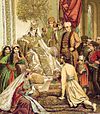David Komnenos
| David Megas Komnenos | |
|---|---|
Manuel Komnenos and grandson of the Emperor Andronikos I .
Capture of TrebizondDavid's life is not well-documented; the primary historian for the Empire of Trebizond, Byzantine Emperor Andronikos I. Their relative Tamar was queen of Georgia; exactly how David and Tamar were related is not clear. According to Michael Panaretos, Queen Tamar was Alexios' paternal relative (προς πατρός θεὶα); Cyril Toumanoff argued that their grandfather Andronikos had, while in Georgia, married an unnamed sister of king George III.[2] More recently Michel Kuršanskis has argued against Toumanoff's theory, producing evidence that Alexios' mother and/or grandmother were daughters of the houses of Palaiologos or Doukas, yet failing to offer an explanation why Panaretos describes Tamar as Alexios' paternal aunt.[3] Whatever the nature of their relationship, after the death of Emperor Andronikos and their father Manuel, Queen Tamar provided a refuge for the boys at the Georgian court, where presumably they were raised and educated.[4]
In April 1204, while Constantinople was occupied with the on-going conflict with the Amastris, Tios and Heraclea Pontica all welcomed him.[9]
Conquests in the WestAt this point David encountered another rival for control of the stricken Byzantine Empire: Theodore Laskaris. Laskaris had neutralized rivals along his southern marches—Sabas Asidenos, Manuel Maurozomes, and Theodore Mangaphas, while frustrating the attempts of Henry of Flanders to expand the newly founded Latin Empire into Anatolia.[10] David dispatched his young general Synadenos with some soldiers to occupy the city of Nicomedia, which had been evacuated by the Latin Empire but Laskaris considered part of his domain, the Empire of Nicaea. Theodore Laskaris strategically circled around Synadenos, leading his men through a difficult pass, and fell upon his enemy's flank with complete surprise. Laskaris was prevented from following up this victory and force David's western frontier to recede further eastwards by the timely action of the Latins under Thierri de Loos of seizing Nicomedia. But a Bulgarian invasion of Thrace forced the Latins to withdraw.[11] For their assistance, David rewarded the Latin Empire with shiploads of grain and hams. Then, considering how Laskaris had encouraged Sultan Plousias. David withdrew, but the Franks, incautiously advancing into the hilly country, were suddenly surprised by Andronikos Gidos, a general of Laskaris, in the Rough Passes of Nicomedia, and scarcely a man of them was left.[13]
In 1208 Laskaris renewed his offensive against David Komnenos at Adrianople to finish rebuilding the city, Henry then crossed the Sea of Marmara and occupied Nicomedia, threatening Laskaris' rear, which forced the latter to lift his siege and return to his own territory. Theodore's withdraw was costly, for he lost about 1000 men in crossing the Sangarios, which was in flood.[14] Henry's army might have seized more land in Bithynia, had not an abominably cold winter swept in preventing his troops from advancing any further.[15]
Despite this setback, Theodore did not abandon his attempts on Paphlagonia. Following the Seljuk defeat at Vatopedi monastery on 13 December 1212.[19] But this evidence raises more questions than it answers, such as how did he become to reside there.
Shukurov looks for the answer in Panaretos' silence, which he believes was intentional and therefore significant: David somehow disgraced himself and was confined to Vatopedi by Alexios.[20] A clue to his offense may lie in William Miller's observation above referring to David's suzerainty to the Emperor of the Latin Empire, a hated enemy of Byzantines. Despite the attested flexibility of Byzantine ideology, his submission might have been too much for his brother to tolerate, and it was this that led to his downfall and confinement. References
Further reading
|

